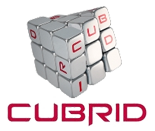A Conversation with Jay Kim and Esen Sagynov of CUBRID.

www.cubrid.org
I participate at the MySQL Conference in Silicon Valley every year and look forward to the diversity of ideas, projects and companies that represent the ever-growing open source database landscape. This year, CUBRID, an open source database project backed by a company from South Korea, caught my eye. What was most impressive to me was the team’s enthusiasm about open source software and its belief that an open source model can work for developing good software and, at the same time, for building a healthy services business in Asia as well as globally.
CUBRID’s team from Korea proudly announced its participation in the global open source ecosystem through the example of its open source relational database project at the conference. I talked with Jay Kim and Esen Sagynov from the CUBRID team about their experience building an open source database in Asia, growing the CUBRID community and increasing its adoption. Here is what they had to say.
1. Tell me about CUBRID?
CUBRID is an open source relational database highly optimized for web applications. In the summer of 2006, NHN, Korea’s top portal and search engine joined the CUBRID project as a major co-developer. After two years of development, in October 2008, CUBRID became an open source project with a GPL v2 or later license. Code development was initially hosted at http://dev.naver.com/projects/cubrid, a CUBRID development project site in Korea. As of October 2009, the project has been now setup at Source Forge.
NHN’s experience in database development and supporting its numerous on-line services provided a great opportunity to develop and scale CUBRID to handle large concurrent requests.The latest version CUBRID 2008 R2.2 was released in May 2010, the next version CUBRID 2008 R3.0 is expected to be released this summer.
2. How has CUBRID used the open source model for development?
CUBRID’s presence in the open source industry has already brought many changes. It is one of the leading open source projects in Korea. With the help of its open source community, CUBRID has been able to deliver 8 releases of CUBRID DBMS at an interval of 1-4 months, twice more frequent than other database providers.
From our experience in Korea, we are trying to develop CUBRID Cluster and CUBRID Manager, a client GUI database administration tool, and spin-off projects with many other developers. All of these projects come to live and continue to be developed because of the open source community. We feel that we create value for both users and developers around CUBRID.
The open source model has helped us not only facilitate development of third-party applications and tools for CUBRID DBMS but also helped generate new ideas and encourage more users.
3. How do you see CUBRID playing in the US market, especially since you have to compete with larger, more entrenched competitors like Oracle and MySQL?
The U.S. has always been the land of opportunity. CUBRID envisions its niche in web applications. Instead of competing with the market leaders, CUBRID is positioned in a slightly different way, being a database highly optimized for web apps, particularly those which drive extremely high traffic with prevailing READ-transactions. It provides enterprise level features for all users under GPL and BSD license.
CUBRID is being used in NHN’s numerous on-line services running on vast amount of servers in several environments, supporting scalability, stability and high performance. This allows CUBRID to support users’ requirements and their bug reports more rapidly. In addition, the average response time at CUBRID Community forum in the fourth quarter 2009 was only 3.6 hours.
We believe, CUBRID can attract users, including enterprises, who really value their own customers and this is the right time for them to get acquainted with CUBRID.
4. Why did you select GPLv2 as CUBRID’s license?
Unlike other databases, CUBRID does not distinguish our license policy between community and enterprise. There is only one version under GNU General Public License version 2.0 or later for the database server engine and under BSD license for the APIs and client tools. This CUBRID Open Source License Policy benefits both companies as well as community users.
We adopted the BSD license for our APIs because we do not want to impose any limitations for developing and distributing valuable products on the top of CUBRID. However, the core part of CUBRID, i.e. the database server engine itself, adopted the GNU General Public License so that any improved features on the server engine can be shared with many other users. For more information, see CUBRID’s Open Source License Policy.
5. How large is CUBRID’s user community?
We’ve gathered statistics related to CUBRID users since its first launch in October 2008. The number of total downloads has topped over 51,000 and latest statistics indicate a growing number of downloads with 3,200 downloads in May 2010 (per month). Also, the number of CUBRID Open Source community web site visitors increases daily. Last April, over 3,000 unique users visited CUBRID project home page.
Currently, there are over 20 active CUBRID open source contributors in Korea. There are also core developers in Romania and China. We are eager to support all interested developers and users to help grow interest in CUBRID. Considering our assumption that Korean database users account for only 1% of the entire global market, we believe the CUBRID community will grow very rapidly in the near future.
6. Has open source helped you grow CUBRID’s user community and convert them into paying customers?
Definitely, yes. Open source, as a whole, facilitates CUBRID development in a number of ways, including improved user awareness and faster adoption, stronger competitive positioning in the database for web industry, and, most importantly, a large base of users to find and report bugs and recommend improvements to CUBRID.
As open source is one of the today’s hot topics, most users and developers positively respond to the idea of holding Open Source Conferences and CUBRID Events. Therefore, we annually hold a CUBRID Bug Bash event. We bring together our experienced software engineers and CUBRID Community users and developers to search for and fix bugs in CUBRID and make code enhancements. NHN IdoCode (Summer of Code) is a large event to bring together professional software developers and enthusiasts to create new or port existing open source software for CUBRID. Those highly interested in open source development eagerly participate in the event and submit significant contributions to CUBRID Project. For instance, WordPress, phpBB, and MediaWiki have been extended to use CUBRID as the database server by our community contributors.
Ubuntu Users Community Guide is a Linux related event CUBRID also takes part in to facilitate the adoption of and software development for Linux Ubuntu OS. CUBRID also recently became a Linux Foundation Silver Sponsor. Linux’ strengths in the enterprise translate into major advantages for supporting web-based businesses. It’s ability to enable seamless high-volume transactions and high performance server/client infrastructure are among the reasons CUBRID has become an active member of the Linux development community and the Linux Foundation.
Additionally CUBRID supports various conferences like JCO Java Developer Conference, Advanced Computing Conference, attends global and local conferences like the O’Reilly MySQL Conference & Expo and Asia-Pacific Web Technology Conference.
We also organize an annual technical seminars called “CUBRID Inside” for our community developers. We discuss various details and challenges around CUBRID, including its three-tier architecture, CUBRID Quality Assurance process, CUBRID Heartbeat implementation, and so forth. As a result, we’ve experienced growing interest in CUBRID DBMS from developers and enterprise users, especially in the local market (Korea).
Nowadays, CUBRID is being actively used by IT industry leader in Korea – NHN Corporation, which deploys a farm of over 10,000 servers. In addition, large hosting companies Cafe24 and Mireene, software company ESTsoft, and many Korean local colleges manage their data with CUBRID. Two third of all CUBRID references come from the government sector. The Korea National Tax Service, Korea Ministry of Public Administration and Security, Korea Ministry of National Defense, Busan Transportation Corporation, and Korea White House are major customers who deployed CUBRID as their major database management software. Just imagine how much sensitive data they all have, how much security they all require – they all chose CUBRID as their database.
7. How would you attract newcomers to your community? What benefits can they expect and how can they contribute?
We often organize events for our community members to encourage their enthusiasm. We hold online seminars to share our knowledge, or bug bash events and distribute prizes for contributors. By participating in these events, newcomers can gain valuable knowledge in development and can share their knowledge with other.
We have enough interesting and exciting projects within CUBRID to get involved in, such as introducing a number of new query-embedded functions, porting existing open source projects for CUBRID, developing a newer version of CUBRID native libraries, and so forth. Besides major development activities, CUBRID community members are welcome to add to CUBRID’s on-line Universal Knowledge Repository by contributing better documentation, more code examples, easy-to-replicate examples, and comprehensive tutorials. Likewise, reporting bugs and providing feedback are also valuable for the community.
We want the CUBRID community to not be a place just to come and go, but to be a community where users stay and enjoy the rapid development process, something most newcomers are seeking for. To make CUBRID projects more beneficial to all, we always welcome any suggestion in every possible way from YOU!
Thanks Jay and Esen for taking the time to talk about CUBRID. Good luck!






